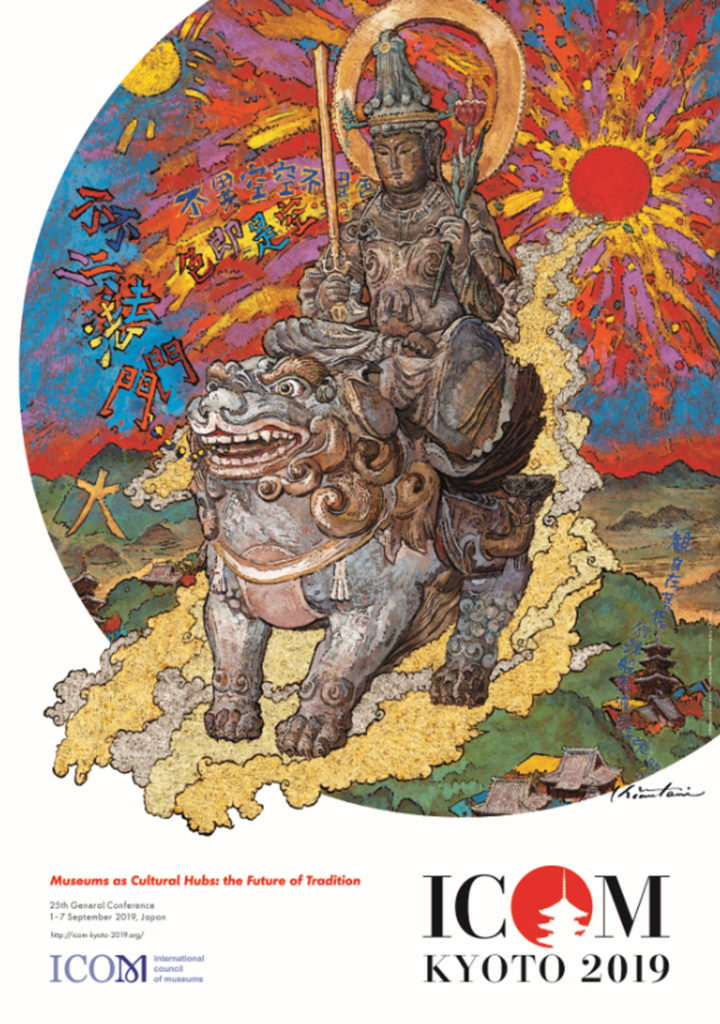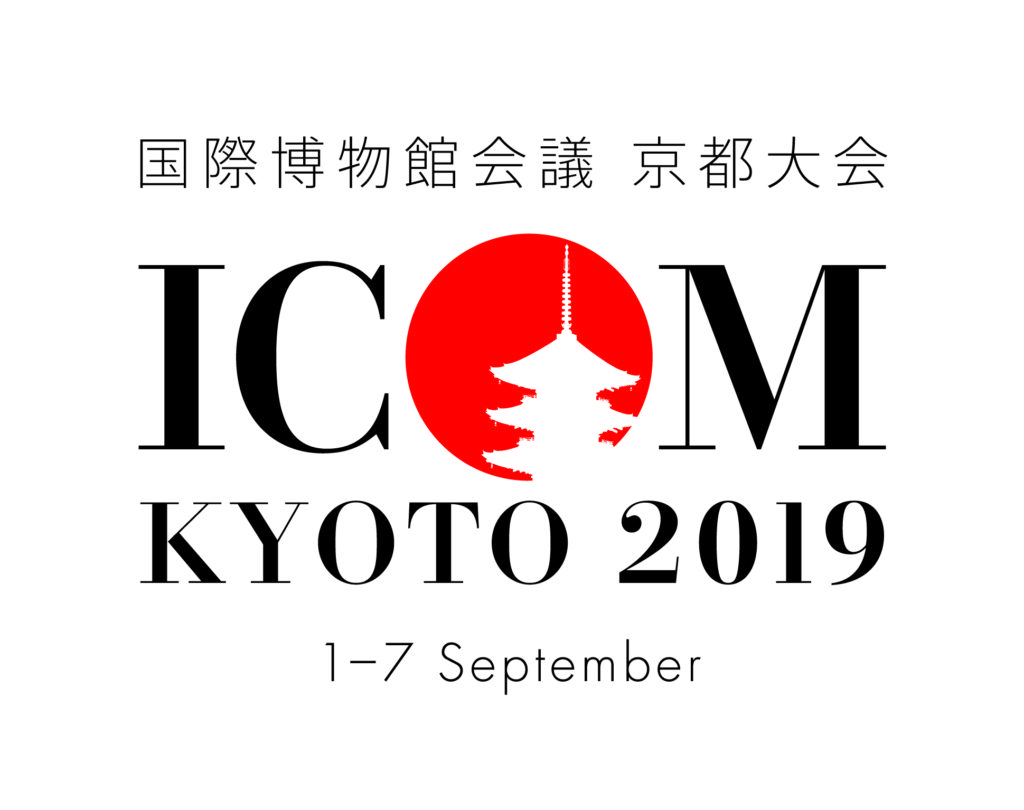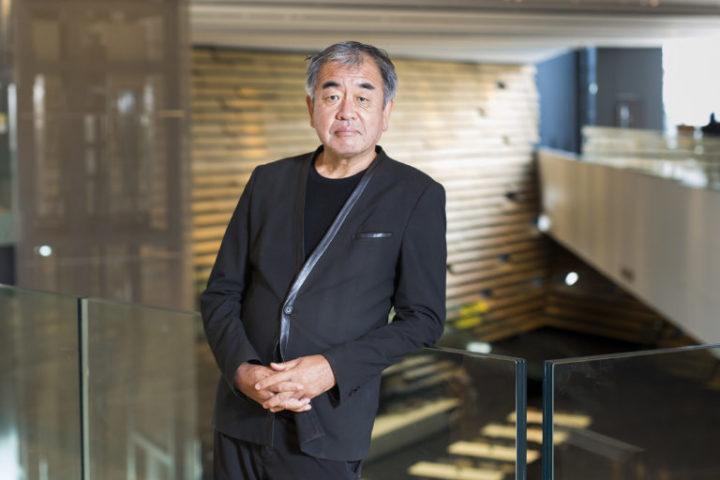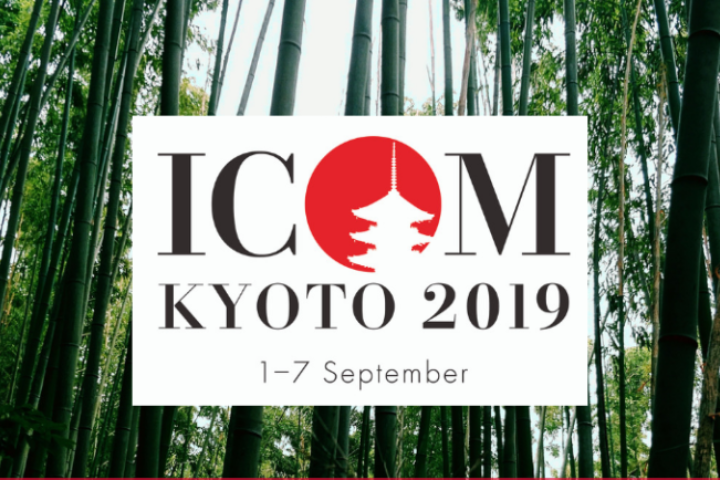We interviewed the renowned Japanese artist Koji Kinutani on the meaning of the painting he created for the 25th ICOM General Conference
Koji Kinutani (1943- ) is a Nara-born Japanese painter. After he mastered fresco technique at Tokyo National University of Fine Arts, he studied abroad at the Academy of Fine Arts of Venice. In 1974, Kinutani became the youngest person to ever receive the Yasui Prize, a touchstone for young Japanese painters. He also designed the official poster of the Nagano Winter Olympics in 1998 and installed public art on the walls of Shibuya Station in 2008.
In 2001, Kinutani was appointed to the Japan Art Academy, and in 2014, he was designated a Person of Cultural Merit for his innovative contributions to Japanese culture and society. Kinutani has created uniquely energetic works by a rich variety of techniques. He also has a strong interest in children’s education and is actively involved in the Kids Dream / Art / Academy, a project started by the Agency for Cultural Affairs and the Japan Art Academy to convey the joys of arts and culture to children.
During the Annual Meetings of ICOM 2018, we interviewed him on the meaning behind the poster he designed for the General Conference of ICOM, which features his painting entitled Light Descends On Kyoto.
How would you describe the ICOM Kyoto 2019 General Conference poster? What did you want to communicate with it?
You can see a Kyoto temple at the bottom of the poster and the Bodhisattva Manjushri descending from the sun. Manjushri is holding a flower in one hand, and in the other hand there’s a sword. These represent the symbiosis of peace and war – two sides of the same coin. To give another example, when making chocolate, we put in salt in addition to sugar. To make a spicy curry, we add sweet things like apples and honey into the savory sauce.
What I want to convey is the spiritual concept of non-dualism, the idea that individual, seemingly contradictory concepts are actually essential parts of a greater whole. In the same way, both positive and negative feelings coexist in our minds. We must live with and learn from both of them every day. Men and women can also be looked at in this way; not as separate entities but rather as essential components of humanity. If you have the wisdom to understand these ideas, then the world will be peaceful. This is the message contained in the poster.
ICOM chose Kyoto to host the General Conference because it is a city that honors tradition at the same time that it fosters a spirit of innovation. In your opinion, what is the future of tradition in Japan?
“The Future of Tradition,” the theme of ICOM Kyoto 2019, is not about two separate things. Past, present, and future are inextricably linked. We are all living and dying within the passage of time, and new things can only come out of what came before. A specific example is our genes, which have been handed down over 360 million years, and will continue to be passed on into the in future. If we really look at past and future in this way, we gain an extraordinarily broad perspective.
I think that it is important to gain this kind of wide view of the world, taking in the complex and dichotomous nature of things that coexist within the greater flow. This is what I had in mind when I created the ICOM poster. The theme of “The Future of Tradition,” recognizes that “old things” are not necessarily “old-fashioned,” but in fact are exactly where we can look to discover the new. It’s sometimes easy to forget that the world we are living is exists within a much longer tradition, and that this tradition is a bridge to the future. In that sense, I think the ICOM Kyoto 2019 has chosen a wonderful theme for its General Conference.

At the Koji Kinutani Tenku Art Museum, you use 3D visuals as well as mixed media paintings. How do you think the use of modern technology changes the way audiences approach your art?
I present a moving world that uses 3D technology to enable the audience to enter into my paintings, and for the painting to advance towards the visitors, while music flows around the museum. This is one of the ways in which I inject a breath of fresh air into my working method – which is very old painting technique called fresco.
Fresco techniques were used by Michelangelo and the Renaissance painters, who created paintings, and thus their connections to the world, while the lime ‘canvas’ was still wet. This way of painting may initially seem old-fashioned. But fresco are painted onto wet walls made by taking burnt limestone and slaking it with water to create hydrated lime – that then absorbs carbon dioxide from the air to set hard. This painting method captures the painting within the very structure of the wall, passing it onto the future – perhaps forever.
The issue of carbon dioxide, CO2, has become one of the modern world’s most significant issues. It is not only plants enabling us to cope with the problem, it is also natural stones breathing in and soaking up carbon dioxide and transforming it into something safe. So, fresco painting might seem to be old-fashioned, but people in those days experienced how lime sucked carbon dioxide out of the air to solidify. There is CO2 in CACO3 and limestone. Without this CO2, it cannot become a stone – and this sort of science enters the world of painting. So, we can see that the question of CO2 came up in fresco painting that used limestone. This is an example of an old theme that is also a very modern theme.
And finally, why do you think people should attend the ICOM Kyoto 2019 General Conference?
I think the museum conference is very important. In many ways, arts and culture are like a beautiful flower – we simply cannot step on a flower. The beauty of the human mind is the same. The museum is the culmination of the beauty of the human mind, and an important legacy for mankind – like a time machine of sorts that can send us to the future. I have a great deal of respect for how the members of ICOM work to develop culture, art and preservation, and it is a great honor to have had the chance to create this poster.
ICOM KYOTO 2019
Between the 1st and the 7th of September 2019, Kyoto (Japan) will host the biggest and most important conference of museums in the world. More than 3.000 museum professionals and experts from all international backgrounds will participate in this triannual event, the 25th General Conference of ICOM. After 24 successful editions, ICOM’s flagship conference has become a worldwide reputed hub for exchange about the topical issues museums tackle today, as well as the most innovative solutions. Early bird registrations will be available until the 30th of April. To find more information on the conference and to register, check the ICOM Kyoto 2019 website.



